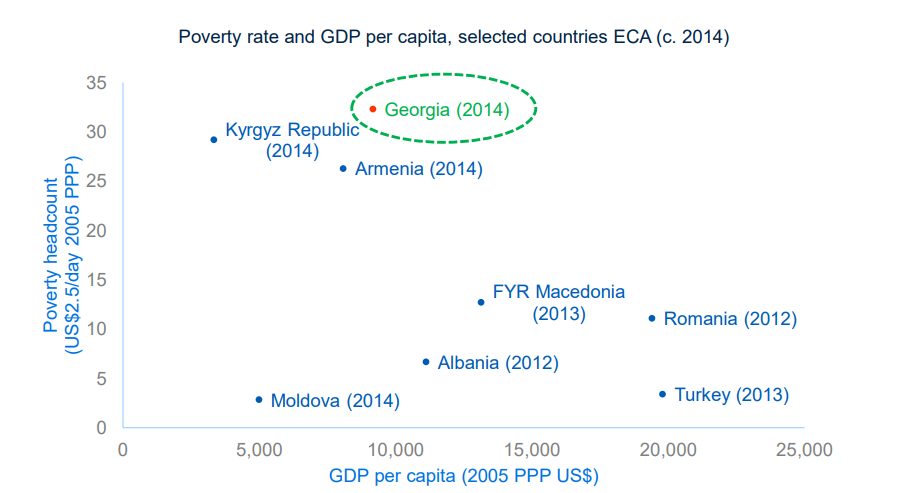“People spend half of their income on food. Seventy percent of Georgia’s population is either moderately or extremely poor.”
FactChecktook interest in the accuracy of the statement.
In his interview with FactCheck,Otar Kakhidze stated that his statement was based on World Bank data.
An assessment of Georgia’s poverty level is given in the World Bank’s 2016 reportwhich is based on 2014 data. According to the report, the daily income of almost one third of Georgia’s population (32%) is less than USD 2.5. This, in accordance with the World Bank’s poverty line determined in 2005, means extreme poverty. Of note is that whilst the reduction of the level of poverty was mostly accomplished at the expense of social transfers before 2010, the role and impact of economic activities increased in 2010-2014. However, the level of poverty in Georgia is quite high as compared to other countries (Kyrgyzstan, Armenia, Macedonia, Albania and Moldova) with the same amount of gross domestic product (GDP).
 Source: World Bank
Source: World Bank
In accordance with the World Bank’s recommendation, particular emphasis should be made on vulnerable groups (people living on the verge of poverty) whose amount in percentage is rising annually (in 2010 it was 15%, in 2011 – 16%, in 2012 – 17%, in 2013 – 21% and in 2014 – 24%). Based on statistics in the report, 32% of Georgia’s population was living in extreme poverty (with less than USD 2.5 in income) in 2014, 37% were poor on average (with a daily income between USD 2.5 to USD 5), 24% belonged to a vulnerable group (with a daily income between USD 5 to USD 10) whilst 7% represented the country’s middle class (with a daily income exceeding USD 10).
 Source: World Bank
The figures
Source: World Bank
The figures published by the National Statistics Office of Georgia differ from those published in the World Bank report. According to the former, the share of Georgia’s population living below the absolute poverty line was 22.4% in 2014 which differs from World Bank statistics by 9.6%.
 Source: National Statistics Office of Georgia
According to the data
Source: National Statistics Office of Georgia
According to the data published by the National Statistics Office of Georgia, food expenses for the population constituted 44% of the total consumption expenses in 2015. However, of note is that this figure has been declining annually (with 2011 being the only exception).
 Source: National Statistics Office of Georgia
Source: National Statistics Office of Georgia
Whilst analysing the population’s food expenses, it is important to take food and consumer price indices into account. The Consumer Price Index represents the structure of expenses of an average consumer of a country. The Consumer Price Index is the only indicator which is used in Georgia to calculate the level of inflation. The Food Price Index is an indicator to measure the monthly change in the basket of food commodities. According to the data of the National Statistics Office of Georgia, the share of food and non-alcoholic beverages in average consumption constitutes 30% whilst prices for food and non-alcoholic beverages increased by 7.4% last year.
Conclusion
According to the World Bank report, basing on data of 2014, 32% of Georgia’s population lives in extreme poverty with expenditure less than 2.5 USD a day, 37% is moderately poor i.e. these people spend 2.5-5 USD a day. 24% of the population is considered vulnerable to revenue reduction and is on the verge of poverty. They spend anywhere between 5 and 10 USD daily. 7% of the population spends over 10 USD per day, which means they belong to middle or high class.
Meanwhile, according to the figures of the National Statistics Office of Georgia, the population’s expenses on food constitute 44% of total consumption expenses as of 2015 (the most recent figures available).
Therefore, FactCheck concludes that Otar Kakhidze’s statement is TRUE.

















